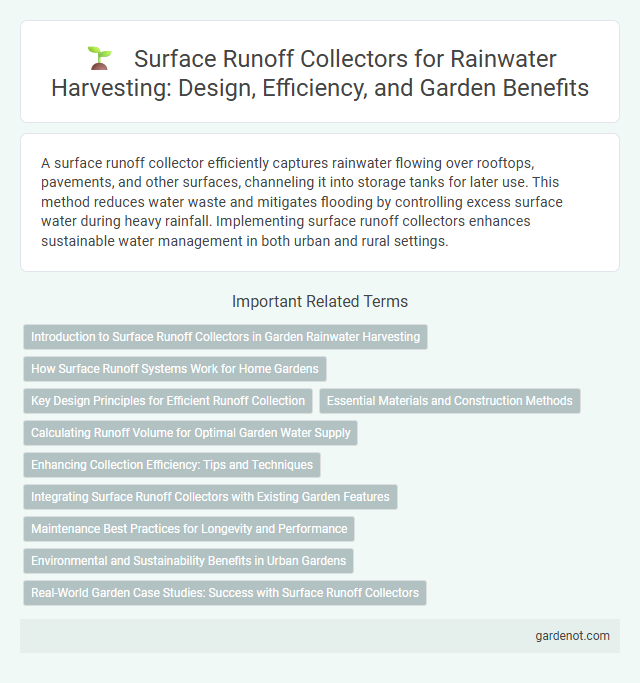A surface runoff collector efficiently captures rainwater flowing over rooftops, pavements, and other surfaces, channeling it into storage tanks for later use. This method reduces water waste and mitigates flooding by controlling excess surface water during heavy rainfall. Implementing surface runoff collectors enhances sustainable water management in both urban and rural settings.
Introduction to Surface Runoff Collectors in Garden Rainwater Harvesting
Surface runoff collectors in garden rainwater harvesting efficiently capture and redirect excess rainwater from impervious surfaces such as rooftops, driveways, and patios. These systems commonly include gutters, channels, and catch basins designed to minimize soil erosion while maximizing water collection for irrigation. Properly implemented surface runoff collectors reduce dependency on municipal water supplies and promote sustainable garden water management.
How Surface Runoff Systems Work for Home Gardens
Surface runoff collector systems capture rainwater flowing over surfaces like roofs and driveways, directing it into storage tanks or garden beds to nourish home gardens. These systems use gutters, channels, and filters to prevent debris from contaminating the collected water, ensuring clean irrigation for plants. Efficient surface runoff harvesting reduces reliance on municipal water, promotes sustainable landscaping, and supports water conservation in residential areas.
Key Design Principles for Efficient Runoff Collection
Surface runoff collectors must be strategically positioned on sloped terrains to maximize water capture while minimizing sediment accumulation. Incorporating durable, non-porous materials and smooth surfaces enhances flow efficiency and reduces blockages. Proper sizing based on catchment area and rainfall intensity ensures optimal storage capacity and consistent water supply.
Essential Materials and Construction Methods
Surface runoff collectors require durable, non-porous materials such as concrete, HDPE, or galvanized steel to effectively channel water without contamination. Construction methods involve grading the catchment area to direct water flow towards the collector, while incorporating filtration screens and sediment traps to improve water quality. Proper sealing and regular maintenance of joints and surfaces ensure long-term efficiency and prevent water loss or infiltration.
Calculating Runoff Volume for Optimal Garden Water Supply
Calculating runoff volume for a surface runoff collector involves measuring the catchment area and local rainfall data to determine the amount of water that can be harvested efficiently. Utilizing the runoff coefficient specific to the surface type, such as concrete or soil, refines volume estimates for garden irrigation needs. Accurate calculations ensure optimal design of storage capacity and irrigation schedules, maximizing water availability during dry periods.
Enhancing Collection Efficiency: Tips and Techniques
Surface runoff collectors maximize rainwater harvesting by strategically positioning channels and gutters to capture optimal water flow from rooftops and paved surfaces. Incorporating filtration screens and sediment traps prevents debris accumulation, improving water quality and system longevity. Regular maintenance and using permeable materials further enhance collection efficiency by reducing clogging and promoting steady runoff capture.
Integrating Surface Runoff Collectors with Existing Garden Features
Integrating surface runoff collectors with existing garden features maximizes water capture while enhancing landscape aesthetics. Utilizing natural slopes, retaining walls, and garden beds as collection points channels rainwater efficiently into storage systems, reducing soil erosion and promoting plant health. Proper placement and design ensure seamless incorporation into the garden's layout, supporting sustainable water management practices.
Maintenance Best Practices for Longevity and Performance
Regular inspection and cleaning of surface runoff collectors prevent debris buildup and ensure efficient water flow. Maintaining inlet and outlet channels free from sediment and vegetation minimizes blockages and structural damage. Applying protective coatings and repairing cracks promptly extends the collector's durability and performance over time.
Environmental and Sustainability Benefits in Urban Gardens
Surface runoff collectors in urban gardens play a crucial role in minimizing water waste by capturing and redirecting rainwater for irrigation, reducing reliance on municipal water supplies. This sustainable practice helps mitigate urban flooding, decreases soil erosion, and supports groundwater recharge, enhancing overall ecosystem resilience. Integrating surface runoff collectors fosters biodiversity by creating healthier soil and plant environments, contributing to greener, more sustainable urban landscapes.
Real-World Garden Case Studies: Success with Surface Runoff Collectors
Surface runoff collectors have proven highly effective in various real-world garden case studies, demonstrating increased water availability for irrigation during dry periods. Gardens utilizing contour trenches and diversion channels capture and redirect rainwater efficiently, reducing soil erosion and enhancing plant growth. Data from multiple urban and rural gardens highlight a 30-50% improvement in water retention and crop yield after implementing surface runoff harvesting techniques.
Surface runoff collector Infographic

 gardenot.com
gardenot.com